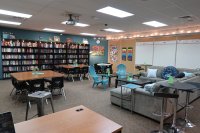Learning to Be Flexible
For middle and high school teachers who avoid lecturing, the switch to flexible seating means the room aligns with their teaching style.
Your content has been saved!
Go to My Saved Content.If you asked my coworkers to describe me, they probably wouldn’t arrive at the word flexible. Routines, to-do lists, and structures calm me. When my roster hit 36 a couple years ago, I shoved yet another desk into my room and carried on. But watching the athletes among my juniors and seniors squeeze into desks made for pre-growth-spurt underclassmen finally made me feel a need for change.
So I jumped at the opportunity when my school district asked teachers to describe, in 140 characters or less, what they would change about their classrooms.
What did I say I wanted to change? Desks. I wanted them gone. I wanted my classroom to feel like home—to be comfortable, to be a space where kids wanted to hang out and read. I asked for a couch, some standing tables, more chairs, and movable desks.
My district’s guide Enriched Classroom Environments & Flex Spaces inspired the elements I incorporated into my redesigned classroom, and though the $1,000 grant wasn’t enough to make every change I wanted, I was able to purchase some of the items on my wish list. I also repurposed old items my district already had, and used some of my own money on the finishing touches (OK, the couch).
Implementation
My less-than-flexible self was nervous about introducing my students to the new space. What if they were heathens and ripped my not-so-cheap couch? What if they weren’t careful taking books off the shelves and scratched my beautiful new chalk paint? What if they couldn’t respect the space or me because the desks weren’t in rows?
I sat down, took a deep breath, and remembered that I have awesome kids and that I work hard to build relationships with them and knew that they would respect my stuff. And I knew that I wouldn’t need to adjust my teaching style to fit flexible seating because flexible seating fit my teaching style better than desks ever had—I had rarely put my old standard desks in rows, for example.
I’m not a teacher who stands in front of the room and lectures. I want to do less work than my kids do in the learning process. I want kids collaborating on a daily basis, working with each other to figure things out, and discovering new ways of looking at the world. I want them so engrossed in a book that they can’t help but lean over to share a laugh about a particular sentence with the person sitting next to them.
I want my kids to feel comfortable and at ease, like they’re sitting at home in their family room with their closest friends and family or at a coffee shop with their favorite book club members. I want a classroom that puts the students at the center, and flexible seating does that for me.
Because I didn’t know what I was getting myself into, I started the 2017–18 school year without many systems in place. I wanted to figure out what I needed to do through trial and error (though I did check out some of the resources available here at Edutopia). Over the course of the year, I developed systems that allowed students to choose what was best for their learning. I required them to try the different seating options and reflect quarterly on where they were most comfortable, focused, and engaged and to consider where they were most distracted or least productive.
I went through the same process this year, but I included a contract noting that not every day would be open seating—that would depend on the class activity—and that arguing over seats would result in a different, assigned seat for everyone.
Challenges
Changing my classroom to incorporate flexible seating has been one of the best decisions I’ve ever made as a teacher. Do I miss having desks? Occasionally. Kids sometimes take a running leap to claim their spot on the couch, lean way back in the Adirondack chairs, or draw stupid things on the café-style tables, and I cringe thinking about the money it would cost to replace the item.
I kindly remind the students that this is their classroom and they should be respectful of the flexibility and seating options—if they destroy their favorite seat, it won’t be there in the future. We need to prepare our kids to be flexible for whatever they decide to do in the future, and part of that preparation comes with acting maturely and being respectful.
Socratic seminars have also presented challenges, but I’ve adjusted and have had kids arrange the other furniture with the couch as part of the circle, and that has worked out. And, of course, I’ve had to remind kids sitting on the couch or floor pillows that sustained silent reading is not nap time—I like to point out how easily they fall asleep when reading and tell them they should probably spend their time before bed with a book instead of a device.
If you were to ask me today if I’m flexible, I’d say I’m learning. I ask my students to take risks, try new things, and learn every day, and I’m right there with them in the process.
